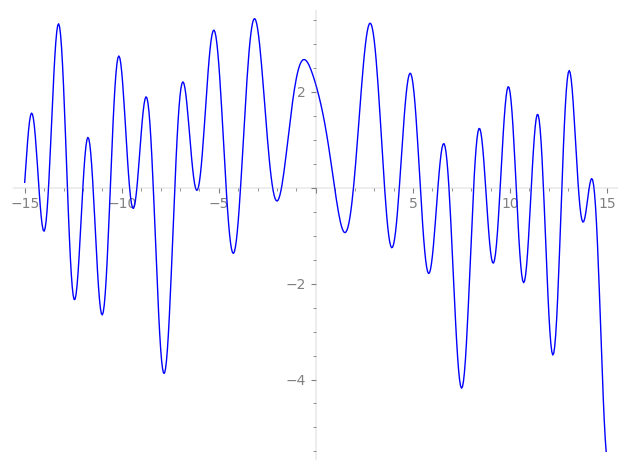| L(s) = 1 | + (2.03 + 0.918i)5-s + (1.31 + 2.29i)7-s + (5.56 + 3.21i)11-s + (1.53 + 1.53i)13-s + (−3.67 + 0.985i)17-s + (−1.19 + 0.687i)19-s + (−8.15 − 2.18i)23-s + (3.31 + 3.74i)25-s − 5.95·29-s + (4.97 − 8.61i)31-s + (0.566 + 5.88i)35-s + (−2.39 − 0.642i)37-s − 1.18i·41-s + (3.28 + 3.28i)43-s + (0.655 − 2.44i)47-s + ⋯ |
| L(s) = 1 | + (0.911 + 0.410i)5-s + (0.495 + 0.868i)7-s + (1.67 + 0.967i)11-s + (0.425 + 0.425i)13-s + (−0.892 + 0.239i)17-s + (−0.273 + 0.157i)19-s + (−1.70 − 0.455i)23-s + (0.662 + 0.748i)25-s − 1.10·29-s + (0.893 − 1.54i)31-s + (0.0957 + 0.995i)35-s + (−0.394 − 0.105i)37-s − 0.184i·41-s + (0.500 + 0.500i)43-s + (0.0955 − 0.356i)47-s + ⋯ |
Λ(s)=(=(1260s/2ΓC(s)L(s)(0.416−0.909i)Λ(2−s)
Λ(s)=(=(1260s/2ΓC(s+1/2)L(s)(0.416−0.909i)Λ(1−s)
| Degree: |
2 |
| Conductor: |
1260
= 22⋅32⋅5⋅7
|
| Sign: |
0.416−0.909i
|
| Analytic conductor: |
10.0611 |
| Root analytic conductor: |
3.17193 |
| Motivic weight: |
1 |
| Rational: |
no |
| Arithmetic: |
yes |
| Character: |
χ1260(53,⋅)
|
| Primitive: |
yes
|
| Self-dual: |
no
|
| Analytic rank: |
0
|
| Selberg data: |
(2, 1260, ( :1/2), 0.416−0.909i)
|
Particular Values
| L(1) |
≈ |
2.141866381 |
| L(21) |
≈ |
2.141866381 |
| L(23) |
|
not available |
| L(1) |
|
not available |
L(s)=p∏Fp(p−s)−1 | p | Fp(T) |
|---|
| bad | 2 | 1 |
| 3 | 1 |
| 5 | 1+(−2.03−0.918i)T |
| 7 | 1+(−1.31−2.29i)T |
| good | 11 | 1+(−5.56−3.21i)T+(5.5+9.52i)T2 |
| 13 | 1+(−1.53−1.53i)T+13iT2 |
| 17 | 1+(3.67−0.985i)T+(14.7−8.5i)T2 |
| 19 | 1+(1.19−0.687i)T+(9.5−16.4i)T2 |
| 23 | 1+(8.15+2.18i)T+(19.9+11.5i)T2 |
| 29 | 1+5.95T+29T2 |
| 31 | 1+(−4.97+8.61i)T+(−15.5−26.8i)T2 |
| 37 | 1+(2.39+0.642i)T+(32.0+18.5i)T2 |
| 41 | 1+1.18iT−41T2 |
| 43 | 1+(−3.28−3.28i)T+43iT2 |
| 47 | 1+(−0.655+2.44i)T+(−40.7−23.5i)T2 |
| 53 | 1+(−0.482−1.80i)T+(−45.8+26.5i)T2 |
| 59 | 1+(3.27−5.67i)T+(−29.5−51.0i)T2 |
| 61 | 1+(−4.09−7.08i)T+(−30.5+52.8i)T2 |
| 67 | 1+(2.49+9.29i)T+(−58.0+33.5i)T2 |
| 71 | 1+8.06iT−71T2 |
| 73 | 1+(−12.9+3.47i)T+(63.2−36.5i)T2 |
| 79 | 1+(−8.00+4.62i)T+(39.5−68.4i)T2 |
| 83 | 1+(5.11−5.11i)T−83iT2 |
| 89 | 1+(3.97+6.88i)T+(−44.5+77.0i)T2 |
| 97 | 1+(0.537−0.537i)T−97iT2 |
| show more | |
| show less | |
L(s)=p∏ j=1∏2(1−αj,pp−s)−1
Imaginary part of the first few zeros on the critical line
−9.596451752232788662192724785924, −9.220180414845295120566320617144, −8.376057602503914177684222852908, −7.26804963625991852504024090296, −6.20670438666246053804474802885, −6.05656609883075790730198934836, −4.62406763801639192182776396284, −3.88124461055396629407306025258, −2.22859278147549796168496882245, −1.77153501487396043615819465719,
0.963237080099873913766715364469, 1.93601786121330708314766830305, 3.53739981884527001171502870724, 4.29585710163474862662965233772, 5.38060776698330216658659287151, 6.28448149047572426527020864697, 6.85268728161917893595601662092, 8.123829455695954972989876567424, 8.745177154022593472555823342607, 9.491773569529085739838779941667

